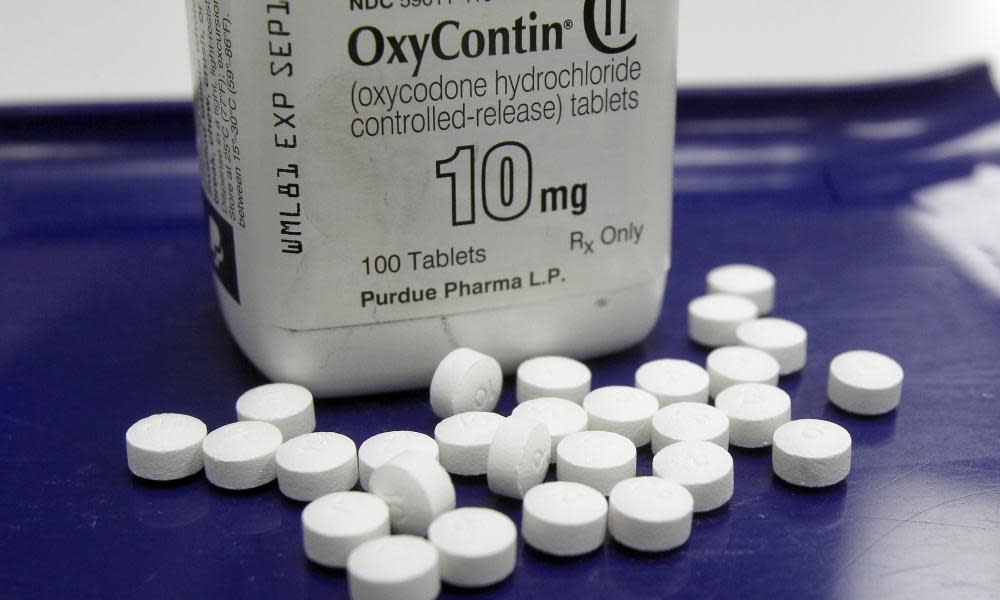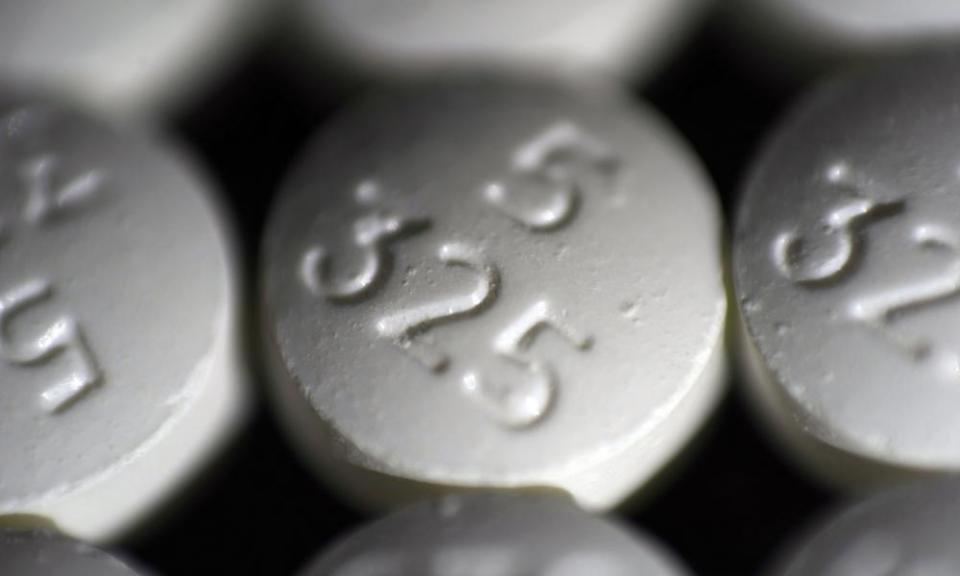Enduring pain: how a 1996 opioid policy change had long-lasting effects

Twenty-two years ago, in 1996, the influential American Pain Society introduced the concept that pain should be treated as a “fifth vital sign”, alongside the normal things doctors routinely check in their patients – body temperature, blood pressure, heart rate and breathing. America’s medical profession broadly welcomed the idea and began to ask patients routinely how much pain they were in.
The same year, the US drug company Purdue Pharma began aggressively marketing a new type of prescription narcotic painkiller, OxyContin, that it claimed was less prone to abuse or dependency than the morphine it mimicked, because it came in the form of slow-release pills.
But these events set the stage for the opioid crisis that unfolded – and persists – currently killing more than 60,000 Americans a year.
Prescriptions began flying off pads in doctors’ offices all over the country, as a class of drug traditionally associated with war wounds, post-surgical acute pain or patients dying of cancer became a routine treatment for chronic conditions like back pain or osteoarthritis.
Almost 100 people are dying every day across America from opioid overdoses – more than car crashes and shootings combined. The majority of these fatalities reveal widespread addiction to powerful prescription painkillers. The crisis unfolded in the mid-90s when the US pharmaceutical industry began marketing legal narcotics, particularly OxyContin, to treat everyday pain. This slow-release opioid was vigorously promoted to doctors and, amid lax regulation and slick sales tactics, people were assured it was safe. But the drug was akin to luxury morphine, doled out like super aspirin, and highly addictive. What resulted was a commercial triumph and a public health tragedy. Belated efforts to rein in distribution fueled a resurgence of heroin and the emergence of a deadly, black market version of the synthetic opioid fentanyl. The crisis is so deep because it affects all races, regions and incomes
Now US experts, including leading members of the American Pain Society (APS), are declaring in the strongest terms yet that opioids are not the answer for chronic pain.
For chronic conditions, “Opioids shouldn’t be on the table to begin with,” said Mark Jensen, editor of the group’s in-house publication, the Journal of Pain, and professor of rehabilitation at the University of Washington, Seattle. “There is no evidence that opioids are helpful. The evidence is they should be offered rarely, if ever.”
A year-long study from the Veterans Health Administration, published in the Journal of the American Medical Association (Jama) earlier this month, concluded that opioids were no more effective against common forms of back and joint pain than acetaminophen, the active drug in brands like Tylenol. Lead author Erin Krebs wrote that “the results do not support initiation of opioid therapy”.
Groups of military veterans recruited from primary care clinics were given different forms of painkillers.
“Treatment with opioids was not superior to treatment with non-opioid medications for improving pain-related function over 12 months,” the report said.
Pain accounts for more than half of primary care visits in the US, according to the Department of Health.
The problem, APS leaders told the Guardian this week, is that opioids merely block pain without treating its source. Many experts now recommend a multi-disciplinary approach, such as physical and sometimes psychological therapies, before turning to prescriptions.
But as medical experts shrink from opioids, “there’s no rationality” to the way that is being implemented, says the outgoing APS president, David Williams, a psychologist at University of Michigan. And that drives people to the black market and street drugs like heroin and fentanyl. “Are we throwing the baby out with the bathwater?” asked Mark Sullivan, a psychiatrist at the University of Washington in a January research article.
Opioid painkillers , such as OxyContin or the many other brand and generic versions that also became bestsellers, do nothing to alleviate the underlying cause of the pain, says Dr John Loeser,an APS member, also at the University of Washington.
“In the chronic pain world everything is [about] function, so it doesn’t matter what the person says, it matters what the person is capable of doing. With opioids you can usually make people say they feel better, but they’re not functionally better.

“We always knew this,” Loeser continues, “but in the 1990s, drug companies came up with patentable opioids, and physicians, who get almost no education about pain in medical school, fell for the marketing.”
Many physiciansabandoned long-held cautions around opioids.
When the APS president, James Campbell, recommended in his 1996 address to the society using a numeric scale for patients to tell doctors how much pain they were in it was intended for use in hospitals. But the recommendation leached out to America’s primary care physicians.
In 2000, the Joint Commission on Accreditation of Healthcare Organizations, a not-for-profit healthcare accreditation body, followed by the Veterans Health Administration, picked up the trend, asserting that physicians must respect patient self-reporting of pain, which routinely came to mean a prescription for a narcotic painkiller.
According to a study in the Harvard Law & Policy Review: “Purdue Pharma successfully contributed to and capitalized on the medical establishment’s changing view of pain management.”
But in 2016, the Joint Commission reversed its position, stating it “does not endorse pain as a vital sign”. In November 2017 four West Virginia cities filed a class-action lawsuit against the commission, alleging that it issued pain management standards in 2001 that downplayed the dangers of opioids.
“The concern back in the mid-90s was underdiagnosis and undertreatment of pain, and the Joint Commission really made a campaign out of it … and the healthcare profession adopted the mantra,” says Roger Fillingim, director of the pain research center at the University of Florida and a past APS president.
And it was lucrative for doctors, as well as corporations. In a Cleveland Clinic Journal of Medicine essay in 2016, editor Brian Mandell reported: “Step forward in time, and pain control has become a measure of patient satisfaction, and … can be linked to reimbursement.”
Simply put, a pain-free patient is a satisfied customer who is more likely to choose that doctor again. Opioids effectively became a marketing tool for a doctor to win the custom of the mighty American consumer.
Americans do not suffer more pain than other nationalities. But they consume prescription opioids at a greater rate than any other population, according to research published in the Washington Post.
And the very American combination of a world-leading, profit-driven pharmaceutical business, a domineering health insurance industry and a finely tuned consumer culture created the perfect storm.
One of the shifts now taking place, Fillingim believes, is from the rights of the individual patient to what’s best for society, which, in the face of a national opioid crisis, are no longer synonymous.
“There’s no such thing as a free lunch,” Fillingim says.
But the difficulty with transitioning from treating pain with opioids to a multi-disciplinary approach, involving costly and slower-acting, non-pharmaceutical therapies, is that no one wants to pay for it, says the APS’s Williams.
So what about that 1996 APS recommendation? “There was a misunderstanding about what pain levels are used for,” says Williams. “Pain levels are used to monitor for intervention and an improvement in function, they’re not absolute thresholds for throwing drugs at patients. There’s a need to assess pain but how you treat it is the issue.”
And, 22 years on, what does the APS’s Loeser see now when he looks out across an America suffering the pain of addiction and death?
“A disaster with no end in sight,” he said.

 Yahoo News
Yahoo News 
